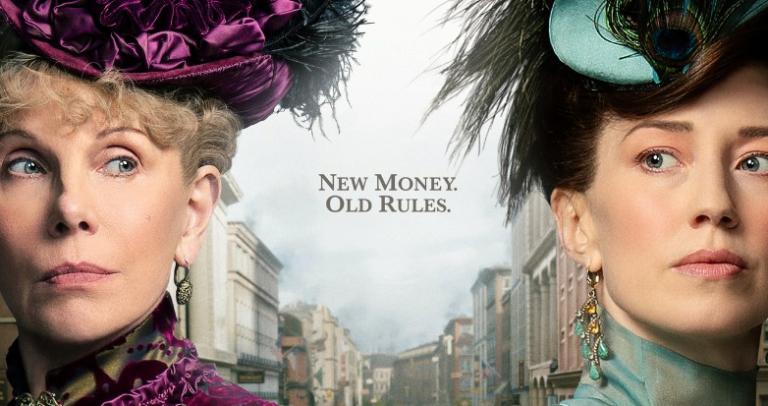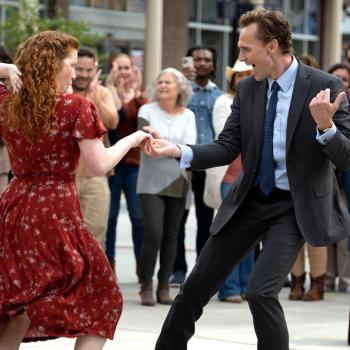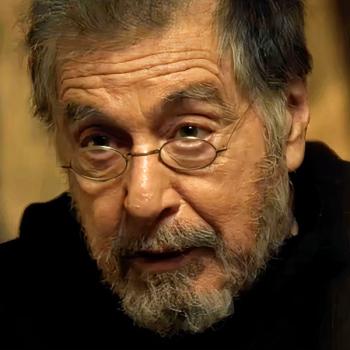
At one point in HBO’s latest opulent drama, The Gilded Age, premiering Jan. 24, a wealthy character comments that money isn’t everything, causing another character to retort that it is, if you don’t have it.
The same can be said of society, especially high society. It doesn’t matter at all, unless you want in, and you can’t get in.
How Does The Gilded Age Stack Up Against the Rest of Julian Fellowes’ Other Costume Dramas?
Money and society and the places they intersect — and don’t — is at the heart of The Gilded Age, the latest upstairs/downstairs creation of British Catholic writer Julian Fellowes (Gosford Park, Downton Abbey, Belgravia).
Originally announced for NBC, it jumped to HBO in 2019, and now makes its debut — with great style if not exactly a splash.
The 10-episode drama (I’ve seen screeners of five) is set in the 1880s in New York City, when the old-money aristocracy of Mrs. Astor’s “The 400” is giving way to pressure from fabulously wealthy railroad barons and other well-heeled upstarts — and they don’t like it.
Halfway through the show, I can say it’s not Gosford Park, it’s sure not Downton Abbey, and it’s not nearly as much fun as Belgravia (more on that one here). Despite high production values and an outstanding cast, it feels … slightly awkward and lacking in the spark that characterized Fellowes’ other costume dramas.
The fault may lie with the character who introduces us to the world of New York. She’s nice and attractive and just a wee bit outspoken, but only a wee bit.
Who’s Who in The Gilded Age?
Louisa Jacobson (daughter of Meryl Streep) stars as twenty-something Marian Brook, a penniless Pennsylvania orphan who must move in with her New York aunts: wealthy widow Agnes Van Rhijn (the redoubtable Christine Baranski) and unmarried Ada Brook (a tremulous Cynthia Nixon), who, like Marian, relies on Agnes’ largesse.
On her way to New York, Marian encounters elegant young African-American Peggy Scott (Denée Benton), an aspiring writer from Brooklyn who winds up working as Aunt Agnes’ secretary.
Across the street from the Van Rhijn house on the corner of 5th Avenue and 61st Street is a huge new mansion built by savvy railroad magnate George Russell (Morgan Spector) and his beautiful, ambitious wife, Bertha (Carrie Coon).
Aunt Agnes wants nothing to do with these social-climbing newcomers, no matter how much money they have, but the paths of Marian and Agnes’ heiress-hunting son, Oscar (Blake Ritson), cross with the Russells nonetheless.
Meanwhile, Marian’s lawyer friend from Pennsylvania, Tom Raikes (Thomas Cocquerel), arrives in New York and has an amazingly easy time moving into high society — and Marian’s orbit.
So, most of the episodes I saw were taken up with Marian getting lots of new dresses and disagreeing with Agnes. This sometimes comes off as ungrateful and unwise, considering she’s poor and entirely dependent on her aunt (who rivals Downton‘s Dowager Countess for sharp comments and incisive observations).
While working as a live-in secretary, Peggy makes some inroads in her writing career. She winds up at the New York Globe, which was a real African-American newspaper in the late 19th Century.
There she meets a character based on a real person, the paper’s co-founder, formerly enslaved man T. Thomas Fortune (Sullivan Jones). Fortune is a man worth knowing about, so I’m hoping this leads to something interesting in future episodes.
Also, Peggy is the daughter of a successful business owner in Brooklyn (John Douglas Thompson and Audra McDonald play her parents) — a family whose prosperity comes as a surprise to the kind but naive Marian.
When we’re not with Marian, we’re having more fun watching Bertha navigate the snubs and veiled (or not-so-veiled) insults of the social lionesses on her determined campaign to raise the fortunes of her family, especially her daughter (Taissa Farmiga).
One goal is to meet social arbiter Ward McCallister (Nathan Lane, essentially playing Col. Sanders), Mrs. Astor’s right-hand man and the gatekeeper to all Bertha wants.
Played by Coon with cool ruthlessness and more than a bit of swagger in her fabulous silk dresses and hats, Bertha is a force of nature.
There Are a Few Spicy Elements, but Overall, The Gilded Age Is Pretty Polite
One of the male characters is gay, which is rather de rigueur these days, but the scenes are fairly restrained. Probably since this is HBO, there is a scene with a topless female at one point, but it doesn’t progress beyond that.
In the episodes I saw, there was no profanity or physical violence. Aside from a brief, mild objection from Aunt Agnes’ household staff and a suspicious but silent store clerk, Peggy encounters remarkably little overt racism. This is a relief from the viciously racist acts that get spotlighted in a lot of shows today, but it doesn’t seem entirely realistic.
But, people do smoke. So, there’s that.
The Gilded Age is an altogether rather decorous affair, with men in white ties and tails, and women wrapped in brilliantly colored silk, organza and lace — which is just what Fellowes likes.
I sat down with him at a press in early 2020, near the premiere of Belgravia on EPIX, and he said:
Some old man, I can’t remember who he was now. But anyway, someone said, “What do you miss most from the world of your youth?” And he said, “The noise of women’s dresses.” The rustling of the silk and all of that, which it’s gone now. And I think that is quite moving as well.
At the midway point in the series, the character that gets in the most trouble is Pumpkin, Aunt Ada’s Cavalier King Charles spaniel.
Does Faith Figure In?
So far, not much. At one point, Peggy quotes Scripture in a newspaper story about real-life Red Cross founder Clara Barton (Linda Emond), but that’s about it.
Nobody is seen going to church or talking about going to church, and no clerics have shown up. I’d guess that most of the 400 were Episcopalian or some sort of mainline Protestant, but I don’t know the denominational breakdown.
The only thing that’s certain is that they were NOT Catholics. New York’s Catholics faced discrimination and were excluded from Gotham’s high society, eventually building one of their own.
Thus Far, The Gilded Age Is Less Than the Sum of Its Parts
All the characters in The Gilded Age have the potential to be interesting, but so far, they’re just not particularly captivating. The show is pleasant to watch, a little soapy, and looks wonderful. But up against Martin Scorsese’s 1993 adaptation of Edith Wharton’s The Age of Innocence or Fellowes’ other work, it just lacks a beating heart.
The Gilded Age is lovely to behold, but halfway through, I don’t yet care much about anybody. Oh, I’ll watch the rest, but it hasn’t quite grabbed me yet.
BTW, for Reference, You Might Want to Begin With The Age of Innocence
Speaking of The Age of Innocence, it’s well worth a look, both as a lush, engrossing movie and as a primer of old New York before The Gilded Age. Set in the 1870s, it takes place during the heyday of the closed world of Mayflower descendants, posh Dutch families generations removed from their trading roots, and scions of the colonial hierarchy.
The grubby origins of everyone’s money have faded into the past, and society’s elites fancy themselves as ladies and gentlemen. But without centuries of European nobility beneath them, they stand on sand, but they’ll defend that sand to the death.
A word or a look or a snub can cut deeply and bring ruin, which Scorsese saw, even under the manners and lace. In a 1993 interview with Roger Ebert, he said:
What has always stuck in my head is the brutality under the manners. People hide what they mean under the surface of language. In the subculture I was around when I grew up in Little Italy, when somebody was killed, there was a finality to it. It was usually done by the hands of a friend. And in a funny way, it was almost like ritualistic slaughter, a sacrifice. But New York society in the 1870s didn’t have that. It was so cold-blooded. I don’t know which is preferable.
Ironically, both The Age of Innocence and The Gilded Age shot in Troy, New York, near Albany. Periods of economic slowdown in the former manufacturing city meant that much of its 19th-Century downtown remained relatively intact, rather than being razed in favor of modern monstrosities.
It probably seemed unfortunate at the time, but it’s worked out for the Collar City in a cinematic sense.
UPDATE 4/14: The series has been renewed for a second season.
Image: HBO
Don’t miss a thing: Subscribe to all that I write at Authory.com/KateOHare














